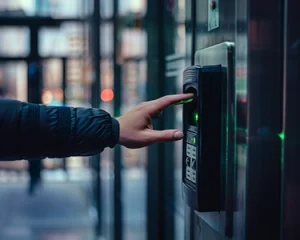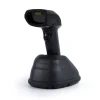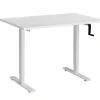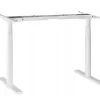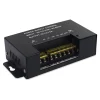The increasingly intense development of transport, the fashion market, or the manufacturing industry generates a demand for modern and precise systems for monitoring objects. Such solutions are offered by RFID technology, which uses radio waves to identify objects from a distance.
In this article, we will take a closer look at RFID technology: its functioning, applications, as well as the benefits and challenges that come with its implementation. Whether you are a technology expert, a logistics manager, or simply someone interested in the latest trends, we invite you to explore this fascinating introduction to the world of RFID.

What is RFID Technology?
In the era of dynamic technological development, one of the key trends gaining popularity is RFID technology – radio identification. This innovative technology, although widely known and applied, is often unnoticed in everyday life, despite affecting many of our actions, from daily shopping and fleet management to complex supply chain management systems. RFID, short for Radio-Frequency Identification, enables the remote writing and reading of information stored on special markers called RFID tags. Unlike barcodes, which require a direct line of sight for scanning, RFID technology can read data through various materials and at different distances, opening up a wide spectrum of application possibilities.
An RFID system typically consists of three key components: RFID tags (also called tags), RFID readers, and a data processing system.
An RFID reader is a device that generates radio waves. When a tag is within range of the reader, the energy from the radio waves activates the tag, which then transmits its data back to the reader. The reader receives this data and passes it to the data processing system (such as a computer or server), which interprets and utilizes it.
Operating Principle
Small devices known as tags are installed on objects. A tag consists of an electronic circuit with stored data and a transceiver antenna. Data is written and read using radio waves generated by the RFID reader, which has an antenna.

What is an RFID Tag?
An RFID tag, sometimes called an RFID marker, is a key component in the radio identification system (RFID). This small device is used to store information that can be read remotely using radio waves.
RFID Tag Structure
An RFID tag consists of two main parts: a microchip and an antenna.
- Microchip – stores data, which can contain various types of information, such as a unique product identifier, location information, product details, owner data, and many others. It takes the form of an integrated circuit that stores information, mostly in accordance with the Class 1 Generation 2 (ISO18000-6C) standard, utilizing 96 bits of memory, which is a sufficient amount of space to store 24 hexadecimal characters (0-9, A-F).
- Antenna – serves to receive radio signals from the RFID reader and to transmit the response, i.e., the data stored in the tag, back to the reader. Its size affects the operating range of the RFID marker. Water and metal absorb and reflect RF waves, significantly reducing the effectiveness of the RFID system. In such environments, special tags are usually used to maintain the system in good condition.
RFID tags can be active, passive, or semi-passive. Active tags have their own power source, which allows them to send a signal over a long distance, while passive tags use the energy received from the reader to power the microchip and to transmit the response. Semi-passive tags have their own power source to power the microchip, but like passive tags, they use the energy received from the reader to transmit the response.
RFID tags are small and lightweight, can be attached to various objects, and even to people or animals. They can also be integrated with other products, for example, they are often embedded in product labels or access cards. RFID tags are particularly useful where remote and automatic monitoring, identification, or tracking of objects is necessary.

Where RFID Technology is Used
The RFID system is an excellent example of advanced technological thought translated into simple functionality. RFID is becoming an integral part of new solutions that gradually usher us into a new technological era. An example is the first unmanned store in Poland, Take & Go.
RFID technology has found widespread application in various aspects of life and economic sectors, both because of its versatility and its ability to precisely track objects. Below are a few examples.
Logistics and Supply Chain Management
RFID allows for the automatic tracking of shipments and products at every stage of the supply chain. This facilitates inventory management, reduces the risk of errors, and allows for faster response to issues.
Retail
In stores, RFID technology is often used to prevent theft and optimize inventory management. For example, RFID tags can monitor in real-time which products leave the store without payment.
Healthcare
In hospitals, RFID tags can be used to track patients, staff, and medical equipment, helping to increase efficiency and safety. RFID can also be used for access authorization to restricted areas or to monitor the temperature of stored medicines and biological samples.
Industry
RFID is used to track components and products on the production line, enabling precise management of production processes and quality control.
Entertainment and Sports
In amusement parks or swimming pools, accessories such as cards or wristbands equipped with RFID are often used for access control to attractions. In sports, RFID tags can be used for automatic time measurement in races.
Animals and Environment
RFID tags can be used for identifying and tracking animals, for example, to monitor wild populations or identify pets.
These are just a few examples. The possibilities for using RFID technology are truly vast and continue to grow with technological progress.

Advantages and Benefits of Using RFID Technology
RFID technology offers numerous benefits that translate into increased efficiency and accuracy across various areas of activity. Here are some of them:
- Automation and Efficiency: RFID technology enables the automatic collection of data without the need to manually scan each item individually. This can result in significant time savings and increase operational efficiency.
- Data Accuracy: RFID reduces the likelihood of errors from manual data entry or barcode scanning. This can improve data quality and information reliability.
- Greater Reading Range: Unlike barcodes, which require a direct line of sight for scanning, RFID tags can be read from a distance and through different materials. This means that RFID tags can be hidden from sight and yet still be effectively scanned.
- Environmental Resistance: RFID tags are often more resistant to harsh environmental conditions, such as moisture, dust, or extreme temperatures, compared to traditional barcodes. This means they are more reliable in challenging conditions.
- Multidirectional Systems Implementation: RFID systems can read multiple tags simultaneously, which allows for the tracking of multiple items at once, such as in inventory management, logistics, or production processes.
- Security: RFID tags can incorporate security features such as data encryption and password protection, which can provide better protection against theft and counterfeiting.
- Integrated Data Management: RFID tags can store more information than barcodes, which enables integrated data management on a single tag.
Despite the numerous benefits, it’s important to remember that the choice of technology should always depend on the specific requirements and conditions of a given application.
Did you know that...
- RFID technology has its roots in World War II, where the first radio identification systems were used to identify aircraft as friend or foe.
- One of the earliest commercial applications of RFID technology was the identification of books in libraries. This allowed for automatic inventory management and the scanning of books during borrowing and returning.
- RFID tags can be incredibly small - some are the size of a grain of sand.
- On the International Space Station (ISS), RFID tags are used to track thousands of tools and other items to ensure that nothing gets lost.
- The first uses of RFID in animal monitoring date back to the 1970s. At that time, it was applied for the identification and tracking of wild animals.
- Many race organizers, such as marathons or triathlons, use RFID technology for precise timing of participants.
- RFID technology is the foundation for mobile payment systems, such as Apple Pay or Google Wallet. Thanks to it, transactions are fast, secure, and convenient.
Devices that Use RFID Technology
We’ve already learned what RFID technology is and how it works, explored its applications, and understood its advantages. Finally, it’s worth mentioning the devices and accessories that use radio waves. RFID technology is utilized in many devices that are used both in business and everyday life. Here are some examples:
- RFID Readers: These are the most popular devices that utilize RFID technology. RFID readers generate radio waves that activate RFID tags, and then receive and interpret the data transmitted back from the tags.
- Access Cards: Access cards for buildings or rooms often use RFID technology for user identification and access authorization.
- RFID Key Fobs: RFID-equipped key fobs, similar to access cards, can be used for user identification and access authorization to specific areas. They are designed as small accessories that, due to their compact size and lightness, can easily be attached to keys.
- Product Labels: Many products in stores are tagged with RFID labels, which allow for automatic inventory tracking and are aimed at preventing theft.
- Temperature Sensors: Some temperature sensors use RFID technology for remote monitoring and recording of temperatures, which is particularly useful in supply chains related to food or medicine.
- Animal Tracking Devices: RFID microchips are often implanted in animals to enable their identification and tracking. They are especially popular among pets.
- Marathon Tags: In races such as marathons or triathlons, participants wear RFID tags that are used for precise timing.
- RFID Wristbands: In various amusement parks, swimming pools, cultural events, and concerts, guests may wear wristbands equipped with RFID tags for access control to attractions and safety monitoring.
- Cars: Some cars use RFID technology for keyless access or ignition. RFID is also used in toll payment systems on highways.

Summary
RFID technology is an incredibly important element of the contemporary technological landscape, playing a crucial role in many sectors, from logistics and supply chain management, through retail, healthcare, industry, to entertainment, sports, and environmental monitoring. Whether used for tracking products in a warehouse, securing access to buildings, monitoring patient health in hospitals, or identifying animals, RFID technology offers numerous benefits, such as automation, increased efficiency, data accuracy, and a broader reading range. As technology evolves, RFID continues to develop, enabling ever-newer applications, from microscopic RFID tags, through use in space, to implementation in mobile payment systems. Moreover, a wide variety of devices utilize RFID technology, from RFID readers, access cards, product labels, temperature sensors, to luggage belts at airports and cars.
In conclusion, RFID technology is a dynamic tool with the potential to transform many aspects of our lives and work. With further technological progress, the possibilities for using this technology are nearly limitless.
![High-level security and control – Access Control Systems [2024]](https://hdwrglobal.b-cdn.net/wp-content/uploads/2024/05/transparent-thegem-product-justified-landscape-s.png)
